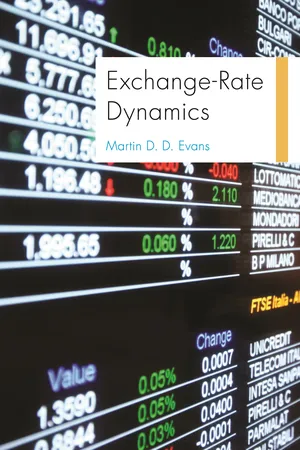
- 600 pages
- English
- ePUB (mobile friendly)
- Available on iOS & Android
Exchange-Rate Dynamics
About this book
A comprehensive and in-depth look at exchange-rate dynamics
Variations in the foreign exchange market influence all aspects of the world economy, and understanding these dynamics is one of the great challenges of international economics. This book provides a new, comprehensive, and in-depth examination of the standard theories and latest research in exchange-rate economics. Covering a vast swath of theoretical and empirical work, the book explores established theories of exchange-rate determination using macroeconomic fundamentals, and presents unique microbased approaches that combine the insights of microstructure models with the macroeconomic forces driving currency trading.
Macroeconomic models have long assumed that agents—households, firms, financial institutions, and central banks—all have the same information about the structure of the economy and therefore hold the same expectations and uncertainties regarding foreign currency returns. Microbased models, however, look at how heterogeneous information influences the trading decisions of agents and becomes embedded in exchange rates. Replicating key features of actual currency markets, these microbased models generate a rich array of empirical predictions concerning trading patterns and exchange-rate dynamics that are strongly supported by data. The models also show how changing macroeconomic conditions exert an influence on short-term exchange-rate dynamics via their impact on currency trading.
Designed for graduate courses in international macroeconomics, international finance, and finance, and as a go-to reference for researchers in international economics, Exchange-Rate Dynamics guides readers through a range of literature on exchange-rate determination, offering fresh insights for further reading and research.
- Comprehensive and in-depth examination of the latest research in exchange-rate economics
- Outlines theoretical and empirical research across the spectrum of modeling approaches
- Presents new results on the importance of currency trading in exchange-rate determination
- Provides new perspectives on long-standing puzzles in exchange-rate economics
- End-of-chapter questions cement key ideas
Frequently asked questions
- Essential is ideal for learners and professionals who enjoy exploring a wide range of subjects. Access the Essential Library with 800,000+ trusted titles and best-sellers across business, personal growth, and the humanities. Includes unlimited reading time and Standard Read Aloud voice.
- Complete: Perfect for advanced learners and researchers needing full, unrestricted access. Unlock 1.4M+ books across hundreds of subjects, including academic and specialized titles. The Complete Plan also includes advanced features like Premium Read Aloud and Research Assistant.
Please note we cannot support devices running on iOS 13 and Android 7 or earlier. Learn more about using the app.
Information
PART I
MACRO MODELS
CHAPTER 1
Macro Models without Frictions
1.1 Preliminaries
1.1.1 Definitions

Table of contents
- Cover
- Title
- Copyright
- Contents
- Preface
- Part I Macro Models
- Part II Microstructure Models
- Part III Micro-Based Models
- References
- Index